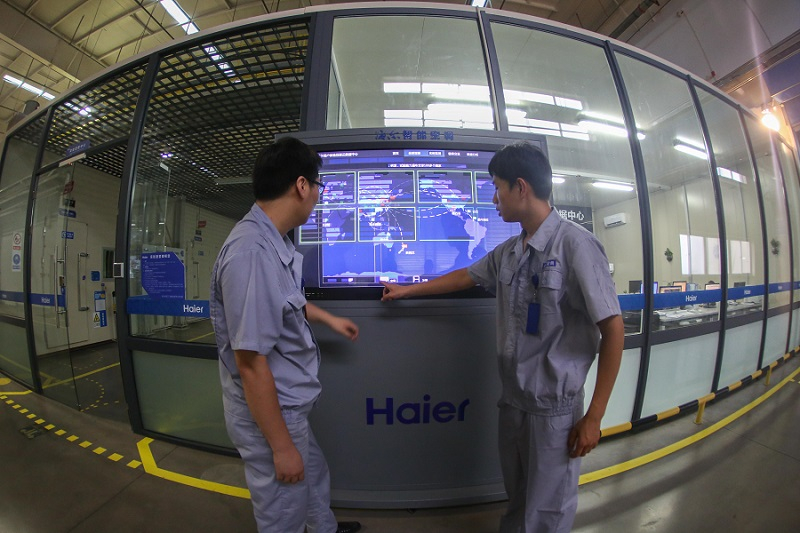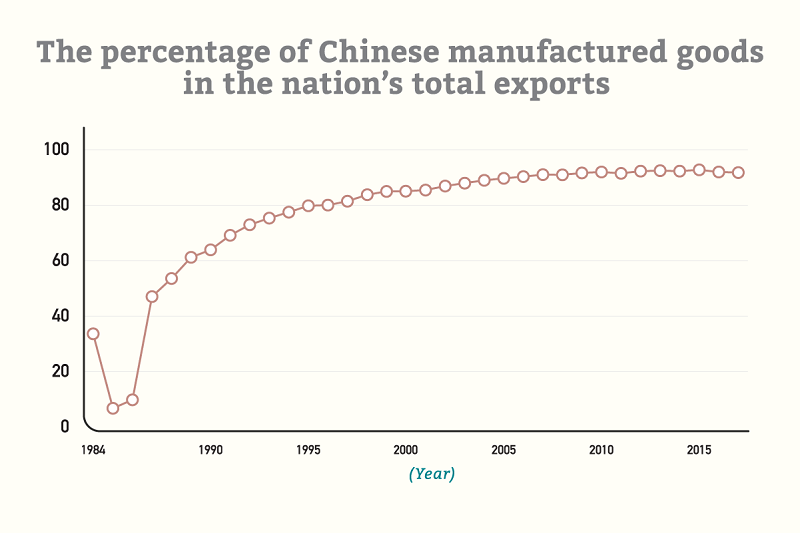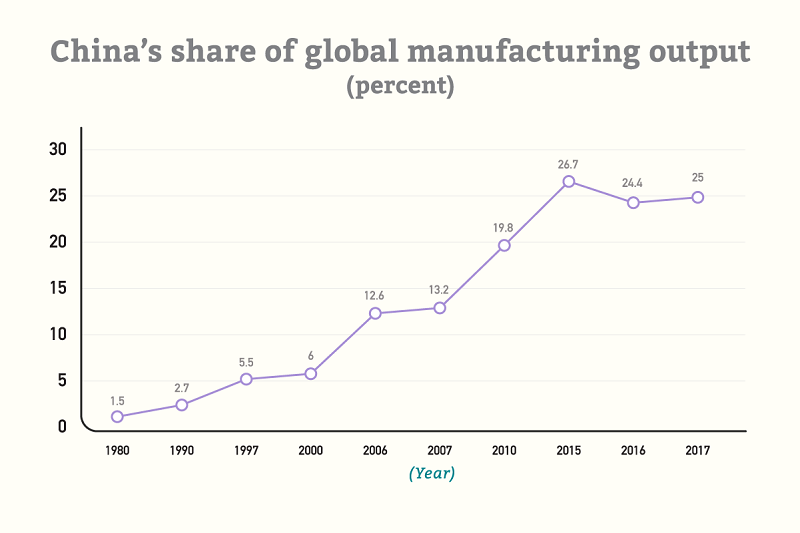Today, products with the Made in China label are ubiquitous. Like it or not, they have become an indispensable part of daily life. Yet, not so long ago, China was still reliant on imports for its basic commodities. How did the nation evolve into a global manufacturing giant and being known as the world’s factory?
The older generation can probably still recall a time when matches, cement and bicycles were called yanghuo (Western fire), yanghui (Western lime) and yangche (Western vehicle) respectively. These expressions are reminders of an era when China was able to manufacture very few items independently and had to import them from foreign countries.
Today, products with the Made in China label are ubiquitous. Some may wish to boycott them but that is easier said than done! Like it or not, Made in China is now an indispensable part of daily life. Yet, not so long ago, Western products were the mainstays of the Chinese consumer market. How did China evolve from being import-reliant for basic commodities to the global manufacturing giant now known for being the world’s factory?
The first three decades - laying the groundwork
The first two industrial revolutions, initiated and led by Western countries, passed China by for the most part. Indeed, in the later part of this era China was actually exploited by industrializing countries. According to figures released by the National Bureau of Statistics (國家統計局) the net value of China’s industrial output was only 4,5 billion yuan back in 1949, with the modern manufacturing industry contributing just 4.3 percent of overall GDP. Thus in 1949 the People’s Republic of China (PRC) inherited a very weak industrial base with low product output and many gaps in its manufacturing capabilities. It was also reliant on imports for most of its raw materials and machinery. A commonly used phrase of the time - Yi qiong er bai (poor and backward both technologically and culturally) - described the general state of the fledgling PRC, including its manufacturing industry.
Transforming China from a backward agrarian nation to a technologically advanced industrial power made the large-scale development of industrial infrastructure a national priority. The first Five-Year Plan required the construction of 694 large and medium-size industrial projects, including 156 major facilities designed with the aid of the Soviet Union. The plan was successfully implemented and the nation began to develop a pool of technical expertise and skilled industrial labor. The plan’s emphasis was on heavy industry and the strategic concentration of capital and resources on developing specific industries. Angang Steel Company (鞍鋼) and the First Automobile Works (第一汽車) were two of the well-known manufacturing enterprises founded at that time.
From 1952 to 1980, China invested 39.55 trillion yuan in its industrial sector and over this period gross domestic product by industry grew by 17.9 times (calculated at comparable price). By 1978, China had fulfilled the objectives of its initial phase of industrial development as scheduled, and succeeded in establishing an independent and relatively complete industrial system. The industrial sector at that time accounted for 44.1 percent of the GDP, and was supported by a wide array of sub-sectors and research and development bodies.
Prior to 1984, China had classified its industries into two broad categories, light industry and heavy industry, based on how they operated and the nature of their respective products. In 1984, the nation established its first industry classification system in the form of the China National Economy Classification Codes (國民經濟行業分類與代碼) which corresponded to the International Standard Industrial Classification of All Economic Activities (ISIC) used by the United Nations Statistical Office. According to this classification system, industries are divided into four major categories: mining, manufacturing, production and supply of electricity, gas and water, and construction.
At that point China’s manufacturing industry was capable of producing both industrial and consumer products, but the bulk of goods produced were industrial. Consumer goods were mainly of a type for meeting basic needs. Overall, the range of products was fairly limited.
China did not produce a dazzling array of consumer goods at that time. This does not mean that the progress achieved during the first 30 years of industrialization was unimportant; nor is it fair to compare it with the progress in industrialization during the more recent years of reform and opening-up. The fact is China could not have become a manufacturing giant without the solid foundation laid during this era. An illustration of this is the BOE Technology Group - considered China’s national pride today. Its roots can be traced to the Beijing Electron Tube Factory (factory no. 774, 北京電子管廠, 774廠) founded in 1956. Up until the 1980s, the Beijing Electron Tube Factory was the backbone of China’s electronics and defense industries, and was the largest electronic components manufacturer in China and a leader of the sector in Asia. Similarly, China’s homegrown large jet C919 (developed by the Commercial Aircraft Corporation of China) and high-speed rail system are the culmination of a three-decade long process of the accumulating and handing down of technological expertise through the generations.
The next four decades - catching up
According to the United Nations Industrial Development Organization (UNIDO), by 1980, China’s share of the world’s manufacturing market had expanded to 3.5 percent, a sign that the nation had joined the ranks of major industrial nations. Since reform and opening-up, China has become increasingly intertwined with the world economy. This has attracted numerous foreign enterprises to the mainland. While state-owned enterprises formed the backbone of the national economy, the non-state-owned sector of the economy also flourished. The two sectors - state-owned and non-state-owned - formed the two “legs” that the manufacturing industry used to advance. Private enterprises, foreign-funded enterprises, joint ventures and cooperative enterprises all emerged within the nation’s manufacturing sector.
As foreign brands entered the Chinese market, domestic manufacturers gained a greater appreciation of the importance of brand reputation and product quality, a realization that was literally hammered home in some cases. For instance, in 1985 Zhang Ruimin (張瑞敏), new head of the Qingdao Refrigerator Plant, used a sledgehammer to smash numerous substandard fridges in front of his workers to make his point about the improvements he expected. When the quality of domestically-manufactured goods improved, many families started to purchase China made electronics and light industrial products. Various product advertisements began making their way into TV programs. A particularly memorable advertisement by Yanwu Radio (燕舞收錄機) became a national sensation. Gradually, China came to have its own brand-name consumer goods. Some products, like the electric fans of the Suzhou-based Changcheng Electrical Equipment and the cameras of Shanghai Hai’ou Camera Equipment, were even viewed as sources of regional pride by the populace in areas where their production plants were based.
By the 1990s, China had largely finished transitioning from a planned economy to a market economy. Private enterprises, with their business acumen and bold pioneering spirit, soon obtained a competitive edge in this process; in contrast, some state-owned enterprises failed to adapt to changes in the market environment and began to decline. Manufacturing industries in the coastal regions quickly took off, with those in the Yangtze River Delta and the Pearl River Delta emerging as the nation’s economic leaders.
According to 1998 statistics, with the exception of a few types of consumer products such as photographic film, coca cola and coffee, China’s consumer goods market was largely dominated by domestic brands. This was particularly the case for the home appliances market, where the top ten best-selling brands for appliances like refrigerators and washing machines were all domestic brands like Rongsheng (容聲) and Little Swan (小天鵝).
At the beginning of the new millennium China received a huge influx of foreign capital. This was largely due to China’s accession to the World Trade Organization, China's policies on attracting foreign investment, and global enterprises’ desire to gain a foothold in the Chinese and Asia-Pacific markets. Many export-oriented manufacturing industries were concentrated in the coastal areas. These soon became the international manufacturing industry’s favorite outsourced production bases, and orders came flooding in. This marks the time when Made in China products, especially IT products, toys and garments, attracted international attention. There was a running joke that if a traffic jam were to occur on the express highway between Shenzhen (深圳) and Dongguan (東莞) global prices for memory chips would soar as a result.
The 2008 financial crisis set off a global wave of industrial restructuring. In response, the Chinese government implemented various policies and initiatives to revitalize its manufacturing industry and steer it through the process of restructuring and upgrading. It promoted energy-efficient and green technologies and fostered the development of emerging industries such as next-generation information technology, biotechnology, high-end equipment manufacturing and new fuel sources. Throughout the process, China’s manufacturing sector shifted from a labor-intensive to a capital-intensive one, then to a skill-intensive one.
Current state and challenges
As predicted by Yicai Research Institute (第一財經研究院) the total output of China’s manufacturing industry overtook that of the United States’ in 2010, and has remained uncontested for several consecutive years. In 2017, China’s manufacturing value added (MVA) reached 24.06 trillion yuan, representing a 160-fold increase from the 1978 MVA of 150 billion yuan.
According to the Industrial Development Report 2018 issued by the United Nations, China’s share of global MVA, which had increased from 12.6 percent in 2006 to 24.4 percent in 2016, is now the highest among all countries. During the same period, the United States saw its share of global MVA decline from 20 percent to 16 percent. The U.S. figure has since remained below 20 percent, placing the country in second place, after the PRC in terms of MVA contribution.
China’s burgeoning industrial power boosted its manufacturing capacity to a completely new level, catapulting Chinese consumers from an age of scarcity to one of unprecedented diversity and abundance. Once unheard of products became available, going from being rare to commonplace. Out of 500 major industrial products in the world, China has been identified as the largest producer of at least 220. In 2018, it was the world’s top automobile producer - for the tenth year in a row - with over 27.8million units produced, as well as the top producer of air conditioners, refrigerators, televisions, tablet PCs, smartphones and numerous types of home appliances and telecommunication products. In 2017, 76 of the world’s top 500 manufacturing enterprises were Chinese. This placed China in third place behind the United States (at 133 enterprises) and Japan (at 85 enterprises) in terms of the best manufacturing companies.
Major factors that have contributed to China’s success include the economies of scale provided by the sheer size of the Chinese market; the nation’s excellent infrastructure acting as a facilitator for industrial development; a sophisticated and self-contained production chain (which comes with highly efficient workers in diverse sectors and a pool of qualified engineers) and the technological expertise that enterprises have accumulated and handed down since the founding of the PRC. Together, they have catapulted the nation’s manufacturing industry to international prominence despite the PRC’s late entry to the competition.
However, the shortcomings of the Chinese manufacturing industry have also become increasingly clear. Hi-tech industries are currently a minority sector and are still at the low-medium end of the industry and value chain. Critical sectors lack core technologies and sufficient capacity in super precision manufacturing and similar advanced manufacturing technologies, and are dependent on foreign technologies. The product quality in certain sectors, where reliability and stability matter most, still has room for improvement; a fact that has undermined brand value at times. The industry’s limited capability for independent innovation has also constrained its further development.
In June 2018, the World Economic Forum and the management consulting firm A.T. Kearney jointly released a report titled Readiness for the Future of Production Report 2018. This report, which compares the state of the manufacturing industry in various nations, placed China in fifth place for the “structure of production” component and the 25th place for the “drivers of production” component. According to the report, China’s performance in terms of levels of innovation within its companies, its labor force capabilities, its resource sustainability and its institutional framework still has much room for improvement. This is in line with an assessment by Miao Wei (苗圩), China’s minister of industry and information technology, that the nation’s manufacturing industry falls in the third tier out of a total four tiers on the world manufacturing map. In short, China may be a manufacturing giant, but has yet to become a manufacturing superpower.
Since the rise of industrial civilization, history has repeatedly shown us that a nation and its people cannot prosper without a strong manufacturing sector. Nations like the United States, Germany, Japan, the United Kingdom and France all developed into economic powerhouses by first becoming manufacturing giants. Manufacturing, as a pillar of any national economy, is the bedrock upon which a nation’s strength is founded. It is also the driver of national development, economic growth, prosperity and innovation, and thus its strength is of paramount importance to every nation. In recent years, developed nations in the West, one after another, have adopted strategies to help their industries gear up for the fourth industrial revolution so as not to lose out in the next round of competition.
In the past two decades, China’s manufacturing sector has advanced along the path towards industry transformation and upgrade, and is shifting its manufacturing focus from low-end to high-end products. The Chinese government has consistently launched policies to bolster its advanced manufacturing sector – so it can develop state-of-the-art manufacturing technologies like 3D printing, industrial robots and artificial intelligence. This has helped these industries scale new heights. In emerging economic sectors like artificial intelligence and biotechnology, a number of startups like iFlytek (科大訊飛) and Megvii Technology (曠視科技) have already emerged as pioneers, poised to blaze a path for the Made in China brands in the upcoming innovation-driven economy. Perhaps, in the not so distant future, China will earn its place as a manufacturing superpower.
References:
Driving Forces of National Economic Growth and their Transition Process (我國經濟增長動力及其轉換),
Statistical Science Research Institute of the National Bureau of Statistics (國家統計局統計科學研究所), Dec. 31, 2014
Chinese Minister on “Made in China” Phenomenon: Chinese Manufacturing Still in Third Tier on World Manufacturing Map and Suffers from Four Major Weaknesses (中國部長談中國製造:尚處世界第三梯隊 存在四大缺陷), dwnews.com, Jul. 7, 2018
A Contest between Nations: How does China’s Manufacturing Industry Measure Up? (國家間的較量:中國製造業究竟水平如何?) finance.sina.com.cn, Sept. 29, 2018
Industrial Development Report 2018
From Laggard to Upstart to Leader: China’s Century-Long Path of Industrialization (1913-2013) (從落伍者、追趕者到超越者:中國工業百年發展之路(1913-2013)) by Hu Angang (胡鞍鋼), Gao Yuning (高宇寧), Yan Yilong (鄢一龍), Zhejiang Social Sciences (浙江社會科學), 2013 Issue 9
Patterns of Manufacturing Development During Reform and Opening Up in China (改革開放進程中的中國製造業發展格局) by Li Jinhua (李金華), Southeast Academic Research (東南學術), 2018 Issue 4
50 Years of New China (1949-1999) (新中國五十年(1949-1999)), China Statistics Press (中國統計出版社 ), 1999 Edition
A Study of the State of the Manufacturing Industry in China and an International Comparison (中國製造業現狀與國際比較研究) by Lin Yulun (林玉倫), Journal of North China Electric Power University (Social Sciences) (華北電力大學學報(社會科學版)), 2010 Issue 3
China's Significant Weight in Global Manufacturing (「中國權重」在全球製造業版圖中舉足輕重), yicai.com, April 9, 2018
Dramatic Changes: Evolution of the Chinese Manufacturing Industry During the Past Three Decades of Reform and Opening-Up (劇變中國:改革開放三十年製造業發展史), Luo Baihui ( 羅百輝), chinavalue.net, Dec. 1, 2008












